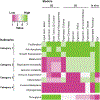Ex Vivo Analysis of Primary Tumor Specimens for Evaluation of Cancer Therapeutics
- PMID: 34222745
- PMCID: PMC8248658
- DOI: 10.1146/annurev-cancerbio-043020-125955
Ex Vivo Analysis of Primary Tumor Specimens for Evaluation of Cancer Therapeutics
Abstract
The use of ex vivo drug sensitivity testing to predict drug activity in individual patients has been actively explored for almost 50 years without delivering a generally useful predictive capability. However, extended failure should not be an indicator of futility. This is especially true in cancer research where ultimate success is often preceded by less successful attempts. For example, both immune- and genetic-based targeted therapies for cancer underwent numerous failed attempts before biological understanding, improved targets, and optimized drug development matured to facilitate an arsenal of transformational drugs. Similarly, the concept of directly assessing drug sensitivity of primary tumor biopsies-and the use of this information to help direct therapeutic approaches-has a long history with a definitive learning curve. In this review, we will survey the history of ex vivo testing as well as the current state of the art for this field. We will present an update on methodologies and approaches, describe the use of these technologies to test cutting-edge drug classes, and describe an increasingly nuanced understanding of tumor types and models for which this strategy is most likely to succeed. We will consider the relative strengths and weaknesses of predicting drug activity across the broad biological context of cancer patients and tumor types. This will include an analysis of the potential for ex vivo drug sensitivity testing to accurately predict drug activity within each of the biological hallmarks of cancer pathogenesis.
Figures

Similar articles
-
Translational Metabolomics of Head Injury: Exploring Dysfunctional Cerebral Metabolism with Ex Vivo NMR Spectroscopy-Based Metabolite Quantification.In: Kobeissy FH, editor. Brain Neurotrauma: Molecular, Neuropsychological, and Rehabilitation Aspects. Boca Raton (FL): CRC Press/Taylor & Francis; 2015. Chapter 25. In: Kobeissy FH, editor. Brain Neurotrauma: Molecular, Neuropsychological, and Rehabilitation Aspects. Boca Raton (FL): CRC Press/Taylor & Francis; 2015. Chapter 25. PMID: 26269925 Free Books & Documents. Review.
-
Macromolecular crowding: chemistry and physics meet biology (Ascona, Switzerland, 10-14 June 2012).Phys Biol. 2013 Aug;10(4):040301. doi: 10.1088/1478-3975/10/4/040301. Epub 2013 Aug 2. Phys Biol. 2013. PMID: 23912807
-
[Preclinical models to establish innovative therapy strategies : Ex‑vivo assessment of head and neck tumor chemo- and immune responses].HNO. 2016 Jul;64(7):460-9. doi: 10.1007/s00106-016-0160-8. HNO. 2016. PMID: 27259639 Review. German.
-
New tools for old drugs: Functional genetic screens to optimize current chemotherapy.Drug Resist Updat. 2018 Jan;36:30-46. doi: 10.1016/j.drup.2018.01.001. Epub 2018 Jan 12. Drug Resist Updat. 2018. PMID: 29499836 Free PMC article. Review.
-
[Aiming for zero blindness].Nippon Ganka Gakkai Zasshi. 2015 Mar;119(3):168-93; discussion 194. Nippon Ganka Gakkai Zasshi. 2015. PMID: 25854109 Review. Japanese.
Cited by
-
Application of precision medicine in clinical routine in haematology-Challenges and opportunities.J Intern Med. 2022 Aug;292(2):243-261. doi: 10.1111/joim.13508. Epub 2022 Jun 4. J Intern Med. 2022. PMID: 35599019 Free PMC article. Review.
-
Patient-Derived Explants of Colorectal Cancer: Histopathological and Molecular Analysis of Long-Term Cultures.Cancers (Basel). 2021 Sep 19;13(18):4695. doi: 10.3390/cancers13184695. Cancers (Basel). 2021. PMID: 34572922 Free PMC article.
-
Robust scoring of selective drug responses for patient-tailored therapy selection.Nat Protoc. 2024 Jan;19(1):60-82. doi: 10.1038/s41596-023-00903-x. Epub 2023 Nov 23. Nat Protoc. 2024. PMID: 37996540 Review.
-
Precision oncology using ex vivo technology: a step towards individualised cancer care?Expert Rev Mol Med. 2022 Oct 3;24:e39. doi: 10.1017/erm.2022.32. Expert Rev Mol Med. 2022. PMID: 36184897 Free PMC article. Review.
-
(Very) Small Stem-like Cells in Human Cell Cultures.Cancers (Basel). 2023 Nov 22;15(23):5520. doi: 10.3390/cancers15235520. Cancers (Basel). 2023. PMID: 38067224 Free PMC article.
References
-
- Ashok A, Choudhury D, Fang Y, Hunziker W. 2020. Towards manufacturing of human organoids. Biotechnol Adv 39(107460. - PubMed
-
- Bouchez LC, Boitano AE, de Lichtervelde L, Romeo R, Cooke MP, Schultz PG. 2011. Small-molecule regulators of human stem cell self-renewal. Chembiochem 12(6): 854–7 - PubMed
-
- Bradley TR, Metcalf D. 1966. The growth of mouse bone marrow cells in vitro. Aust J Exp Biol Med Sci 44(3): 287–99 - PubMed
Grants and funding
- U01 CA224012/CA/NCI NIH HHS/United States
- R44 CA224994/CA/NCI NIH HHS/United States
- P50 CA217685/CA/NCI NIH HHS/United States
- U54 CA224019/CA/NCI NIH HHS/United States
- U2C CA233280/CA/NCI NIH HHS/United States
- U01 CA195469/CA/NCI NIH HHS/United States
- U54 CA209988/CA/NCI NIH HHS/United States
- U01 CA217862/CA/NCI NIH HHS/United States
- R01 CA186241/CA/NCI NIH HHS/United States
- R01 CA196228/CA/NCI NIH HHS/United States
- P30 CA069533/CA/NCI NIH HHS/United States
- U54 HG008100/HG/NHGRI NIH HHS/United States
- R01 CA214428/CA/NCI NIH HHS/United States
- P50 CA098258/CA/NCI NIH HHS/United States
- U01 CA217842/CA/NCI NIH HHS/United States
- R01 CA183974/CA/NCI NIH HHS/United States
LinkOut - more resources
Full Text Sources
